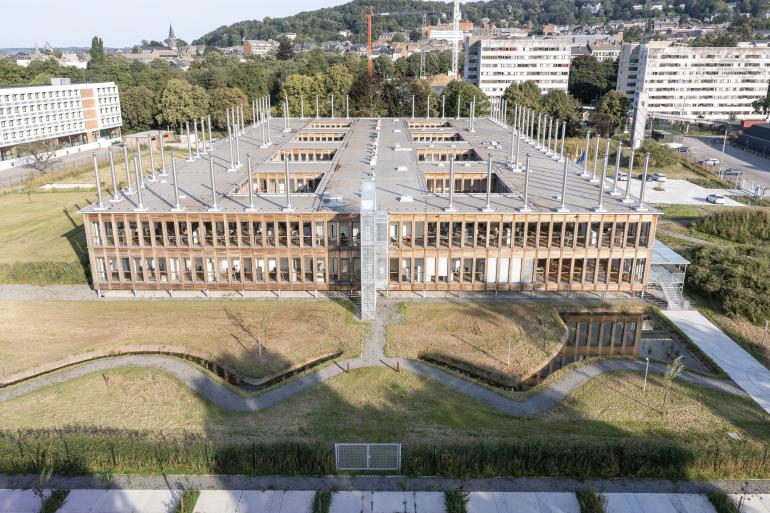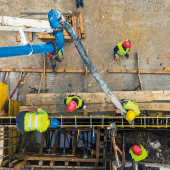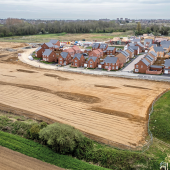Interview: Sir Philippe Samyn

In the first of a series of case studies looking at world-leading sustainable developments, we speak to Sir Philippe Samyn about his BREEAM Award-winning Maison Administrative de la Province de Namur.
Local government administrative headquarters aren’t necessarily known for being at the forefront of building design and technology but, then again, local government facilities aren’t often created by one of the world’s leading architects and building engineers. The Belgian Namur region’s new administrative building is more than a little different though. Even before you know whose minds and hands went into its construction, visually, it is a striking design.
Nestled in a hollow in a bend of the Sambre River on the outskirts of the city of Namur, this entirely timber and steel-built building features two 3.6m-high levels resting on steel piles, with a submerged roof for use as a water tower. The layout is based on eight rectangular patios, each covered by an operable greenhouse glass roof, allowing the provision of fresh air to the building without the need for mechanical ventilation. The design of the patios also allows as much natural light as possible to enter, meaning floor areas can be illuminated naturally.
Perfect conditions
The notable design and intelligent use of materials is a hallmark of the building’s creator: Sir Philippe Samyn. With a portfolio that includes countless iconic buildings, including the Europa European Council building, the European Space Agency building in Redu, and even the Belgian Antarctic Base, Sir Philippe is one of Belgium’s – and, indeed, one of Europe’s – leading architects when it comes to creating magnificent but eminently practical and sustainable buildings.
“Both the first project I had in Namur [the Maison de la Culture de la Province de Namur] and for this Maison Administrative, the administration approved a design-build approach. I think this is a very clever strategy. We favour design-build projects a great deal because we work with a building partner who is extremely competent,” Sir Philippe says.
“To be specific about the Maison Administrative, in the specifications the client took the time to write three pages expressing their philosophical intentions. Unlike many clients who come into these projects with a lot of goodwill but not necessarily the dedication to see it through, in this case the client meant it and wanted it. What we see in a lot of international competition is that a lot of people are asking for a sustainable approach but they aren’t actually ready to support the consequences of it.
“In this case, the sky was the limit for this client. We had a marvellous general contractor, Jan De Nul and I also benefitted from a total confidence from my client. That is what you need: a clear vision of the client; confidence in team members; and then the recognition that we all lack dreadfully when it comes to imagination.
“We have to realise that we know very little and we need to learn more every day. The plan is to work together and to listen to each other. As lead designer, my first obligation is to be like the conductor of a symphony orchestra: I need to listen to everyone, to be sure that the orchestra is playing in harmony. Although at the same time, I am also writing the music!”
Sustainability within reach
Sir Philippe’s reference to unfulfilled good intentions – and sometimes big ideas that perhaps promise more than they can deliver – is counteracted by his focus on simple but eminently sensible design factors. For example, the Namur building’s individual level heights of 3.6m are specified for good reason.
“Think about when you need to clean a building or replace something on the outside. To make it sustainable, you want to remove the need to use a crane to do that. Everything needs to be accessible at a maximum of 3.6m height – the height of a normal ladder. By doing that, you significantly reduce the energy need during the lifecycle of the building. This building in Namur has been conceived so that you can maintain it at human height,” notes Sir Philippe.
Even with fully invested clients, superb contractors and huge amounts of experience – and despite the fact that the building was recognised at the 2022 BREEAM Awards, winning the Regional Award for Western Europe – compromises were made that Sir Philippe said resulted in the building being ‘not quite perfect’. For example, the plan to fit a photovoltaic canopy fell foul to officialdom, as did the idea for the building’s workers to bring in a piece of their own beloved furniture.
“If you look at a classic commercial building, the poor people in those buildings have to live with industrial furniture: so-called ‘ergonomic’ stuff. But, in parallel, all those people at home enjoy a cupboard or a chair or a sofa – perhaps something that belonged to their grandparents and has a family history. So they jump from a commercial industrial product to something with history, but they can work just as happily on their sofa at home as they can on their ergonomic chair in their ergonomic office building,” says Sir Philippe.
“At Namur, we proposed that all those employees should be allowed to bring a piece of their family furniture into the building. That would bring the spirit of Namur and its people and its culture into the building. But then the labour union said, no, this doesn’t comply with labour legislation regarding the ergonomic requirements of office furniture. So you quickly understand there are limits to sustainability.”
Such frustrations aside, the Maison Administrative de la Province de Namur is another important step along the road of reducing the environmental impact of municipal buildings across Europe, and another unique development from the pen of one of Belgium’s most iconic building designers.
To learn more about Sir Philippe’s ideas regarding sustainability – and his battles with European legislative culture – read our exclusive interview with him in the upcoming September edition of Building Engineer.
¹ NOTE: Working at height regulations will vary from country to country.









